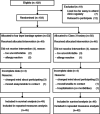The effectiveness of a four-layer compression bandage system in comparison with Class 3 compression hosiery on healing and quality of life in patients with venous leg ulcers: a randomised controlled trial
- PMID: 22716129
- PMCID: PMC7950767
- DOI: 10.1111/j.1742-481X.2012.01033.x
The effectiveness of a four-layer compression bandage system in comparison with Class 3 compression hosiery on healing and quality of life in patients with venous leg ulcers: a randomised controlled trial
Abstract
An increasing number of compression systems available for treatment of venous leg ulcers and limited evidence on the relative effectiveness of these systems are available. The purpose of this study was to conduct a randomised controlled trial to compare the effectiveness of a four-layer compression bandage system and Class 3 compression hosiery on healing and quality of life (QL) in patients with venous leg ulcers. Data were collected from 103 participants on demographics, health, ulcer status, treatments, pain, depression and QL for 24 weeks. After 24 weeks, 86% of the four-layer bandage group and 77% of the hosiery group were healed (P = 0·24). Median time to healing for the bandage group was 10 weeks, in comparison with 14 weeks for the hosiery group (P = 0·018). The Cox proportional hazards regression found participants in the four-layer system were 2·1 times (95% CI 1·2-3·5) more likely to heal than those in hosiery, while longer ulcer duration, larger ulcer area and higher depression scores significantly delayed healing. No differences between groups were found in QL or pain measures. Findings indicate that these systems were equally effective in healing patients by 24 weeks; however, a four-layer system may produce a more rapid response.
Keywords: Compression; Quality of life; Varicose ulcer; Wound healing.
© 2012 The Authors. International Wound Journal © 2012 Medicalhelplines.com Inc and John Wiley & Sons Ltd.
Figures
Similar articles
-
Clinical and cost-effectiveness of compression hosiery versus compression bandages in treatment of venous leg ulcers (Venous leg Ulcer Study IV, VenUS IV): a randomised controlled trial.Lancet. 2014 Mar 8;383(9920):871-9. doi: 10.1016/S0140-6736(13)62368-5. Epub 2013 Dec 6. Lancet. 2014. PMID: 24315520 Clinical Trial.
-
VenUS IV (Venous leg Ulcer Study IV) - compression hosiery compared with compression bandaging in the treatment of venous leg ulcers: a randomised controlled trial, mixed-treatment comparison and decision-analytic model.Health Technol Assess. 2014 Sep;18(57):1-293, v-vi. doi: 10.3310/hta18570. Health Technol Assess. 2014. PMID: 25242076 Free PMC article. Clinical Trial.
-
A randomised controlled trial of compression therapies for the treatment of venous leg ulcers (VenUS 6): study protocol for a pragmatic, multicentre, parallel-group, three-arm randomised controlled trial.Trials. 2023 May 26;24(1):357. doi: 10.1186/s13063-023-07349-2. Trials. 2023. PMID: 37237393 Free PMC article.
-
A Meta-analysis to Compare Four-layer to Short-stretch Compression Bandaging for Venous Leg Ulcer Healing.Ostomy Wound Manage. 2018 May;64(5):30-37. Ostomy Wound Manage. 2018. PMID: 29847309 Review.
-
Effect of different compression bandaging techniques on the healing rate of venous leg ulcers: a literature review.Br J Community Nurs. 2020 Jun 2;25(Sup6):S20-S26. doi: 10.12968/bjcn.2020.25.Sup6.S20. Br J Community Nurs. 2020. PMID: 32501762 Review.
Cited by
-
Medical compression therapy of the extremities with medical compression stockings (MCS), phlebological compression bandages (PCB), and medical adaptive compression systems (MAC) : S2k guideline of the German Phlebology Society (DGP) in cooperation with the following professional associations: DDG, DGA, DGG, GDL, DGL, BVP.Hautarzt. 2021 Dec;72(Suppl 2):37-50. doi: 10.1007/s00105-020-04706-z. Epub 2021 Jan 1. Hautarzt. 2021. PMID: 33386416 Free PMC article. Review. No abstract available.
-
[Effectiveness of double-layered compression therapy against crepe bandage for healing venous ulcers in primary care. Randomized clinical trial].Aten Primaria. 2020 Dec;52(10):712-721. doi: 10.1016/j.aprim.2020.01.010. Epub 2020 Apr 8. Aten Primaria. 2020. PMID: 32278578 Free PMC article. Clinical Trial. Spanish.
-
Relationships between anxiety, depression and wound healing outcomes in adults: A systematic review and meta-analysis.PLoS One. 2025 May 20;20(5):e0309683. doi: 10.1371/journal.pone.0309683. eCollection 2025. PLoS One. 2025. PMID: 40392872 Free PMC article.
-
Allogeneic ABCB5+ mesenchymal stem cells for treatment-refractory chronic venous ulcers: a phase I/IIa clinical trial.JID Innov. 2022 Jan;2(1):100067. doi: 10.1016/j.xjidi.2021.100067. Epub 2021 Oct 25. JID Innov. 2022. PMID: 34870260 Free PMC article.
-
Evidence-Based Clinical Practice Points for the Management of Venous Ulcers.Indian J Surg. 2018 Apr;80(2):171-182. doi: 10.1007/s12262-018-1726-3. Epub 2018 Jan 27. Indian J Surg. 2018. PMID: 29915484 Free PMC article. Review.
References
-
- Anand S, Dean C, Nettleton R, Praburaj D. Health‐related quality of life tools for venous‐ulcerated patients. Br J Nurs 2003;12:48–59. - PubMed
-
- Abbade LPF, Lastoria S. Venous ulcer: epidemiology, physiopathology, diagnosis and treatment. Int J Dermatol 2005;44:449–56. - PubMed
-
- Gordon LG, Edwards H, Courtney M, Finlayson K, Shuter P, Lindsay E. A cost‐effectiveness analysis of two community models of nursing care for managing chronic venous leg ulcers. J Wound Care 2006;15:348–53. - PubMed
-
- Brem H, Kirsner RS, Falanga V. Protocol for the successful treatment of venous ulcers. Am J Surg 2004;188:1S–8S. - PubMed
-
- Franks PJ, McCullagh L, Moffat C. Assessing quality of life in patients with chronic leg ulceration using the Medical Outcomes Short Form‐36 questionnaire. Ostomy Wound Manage 2003;49: 26–37. - PubMed
Publication types
MeSH terms
LinkOut - more resources
Full Text Sources


